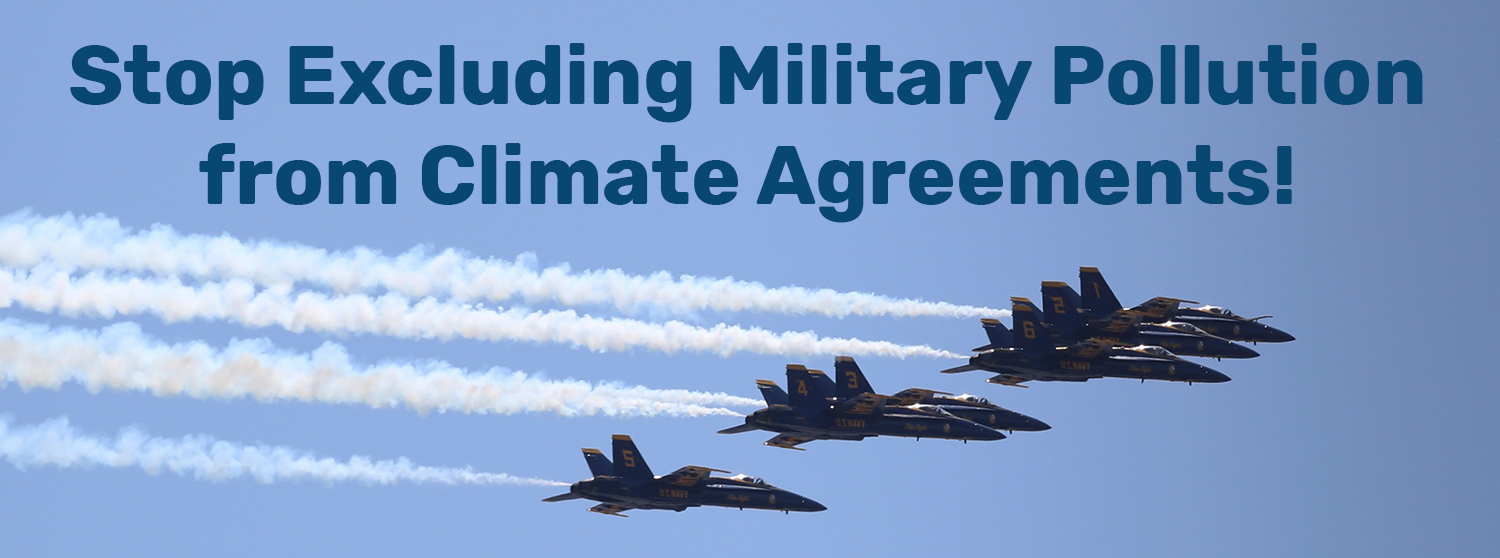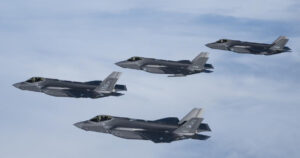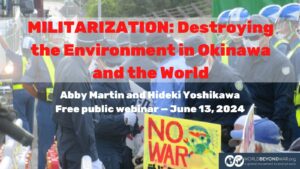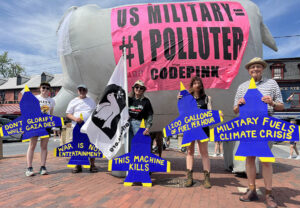The Basic Case
Why Protecting the Environment Is A Reason to End All War
Global militarism presents an extreme threat to the Earth, causing massive environmental destruction, impeding cooperation on solutions, and channeling funding and energies into warmaking that are needed for environmental protection. War and war preparations are major polluters of air, water, and soil, major threats to ecosystems and species, and such a significant contributor to global heating that governments exclude military greenhouse gas emissions from reports and treaty obligations.
If current trends don’t change, by 2070, 19% of our planet’s land area — home to billions of people — will be uninhabitably hot. The delusional idea that militarism is a helpful tool to address that problem threatens a vicious cycle that ends in catastrophe. Learning how war and militarism drive environmental destruction, and how shifts toward peace and sustainable practices can reinforce each other, offers a way out of the worst case scenario. A movement to save the planet is incomplete without opposing the war machine – here’s why.
A Massive, Concealed Danger
In comparison to other large climate threats, militarism does not get the scrutiny and opposition it deserves. A decidedly low estimate of global militarism’s contribution to global fossil fuel emissions is 5.5% – roughly twice the greenhouse gasses as all non-military aviation. If global militarism were a country, it would rank fourth in greenhouse gas emissions. This mapping tool gives a look at military emissions by country and per capita in more detail.
The U.S. military’s greenhouse gas emissions in particular are more than those of most entire countries, making it the single biggest institutional culprit (i.e., worse than any single corporation, but not worse than various entire industries). From 2001-2017, the U.S. military emitted 1.2 billion metric tons of greenhouse gasses, equivalent to the annual emissions of 257 million cars on the road. The U.S. Department of Defense (DoD) is the largest institutional consumer of oil ($17B/year) in the world – by one estimate, the U.S. military used 1.2 million barrels of oil in Iraq in just one month of 2008. Much of this massive consumption sustains the sheer geographical spread of the U.S. military, which spans at least 750 foreign military bases in 80 countries: one military estimate in 2003 was that two-thirds of the U.S. Army’s fuel consumption occurred in vehicles that were delivering fuel to the battlefield.
Even these alarming figures barely scratch the surface, because military environmental impact goes largely unmeasured. This is by design – final-hour demands made by the U.S. government during negotiation of the 1997 Kyoto treaty exempted military greenhouse gas emissions from climate negotiations. That tradition has continued: The 2015 Paris Agreement left cutting military greenhouse gas emissions to the discretion of individual nations; the UN Framework Convention on Climate Change obliges signatories to publish annual greenhouse gas emissions, but military emissions reporting is voluntary and often not included; NATO has acknowledged the problem but not created any specific requirements to address it. This mapping tool exposes the gaps between reported military emissions and more probable estimates.
There is no reasonable basis for this gaping loophole. War and war preparations are major greenhouse gas emitters, more so than numerous industries whose pollution is treated very seriously and addressed by climate agreements. All greenhouse gas emissions need to be included in mandatory greenhouse gas emission reduction standards. There must be no more exception for military pollution.
We asked COP26 and COP27 to set strict greenhouse gas emissions limits that make no exception for militarism, include transparent reporting requirements and independent verification, and do not rely on schemes to “offset” emissions. Greenhouse gas emissions from a country’s overseas military bases, we insisted, must be fully reported and charged to that country, not the country where the base is located. Our demands were not met.
And yet, even robust emissions-reporting requirements for militaries would not tell the entire story. To the damage of militaries’ pollution should be added that of the weapons manufacturers, as well as the enormous destruction of wars: the oil spills, oil fires, methane leaks, etc. Militarism should also be implicated for its extensive siphoning of financial, labor, and political resources away from urgent efforts towards climate resilience. This report discusses externalized environmental impacts of war.
Furthermore, militarism is responsible for enforcing the conditions under which corporate environmental destruction and resource exploitation can take place. For example, militaries are used to guard oil shipping routes and mining operations, including for materials largely desired for the production of military weapons. Researchers looking into the Defense Logistics Agency, the organization responsible for procuring all the fuel and kit the military needs, note that “corporations are… reliant on the U.S. military to secure their own logistical supply chains; or, more precisely… there is a symbiotic relationship between the military and corporate sector.”
Today, the U.S. military is increasingly integrating itself into the commercial sphere, blurring the lines between civilian and warfighter. On Jan 12, 2024, the Department of Defense released its first National Defense Industrial Strategy. The document outlines plans to shape supply chains, the workforce, domestic advanced manufacturing, and international economic policy around the expectation of war between the U.S. and “peer or near-peer competitors” like China and Russia. Tech companies are ready to jump on the bandwagon – just days before the release of the document, OpenAI edited the usage policy for its services like ChatGPT, deleting its ban on military use.
A Long Time Coming
The destruction of war and other forms of environmental harm have not existed in many human societies, but have been a part of some human cultures for millennia.
At least since the Romans sowed salt on Carthaginian fields during the Third Punic War, wars have damaged the earth, both intentionally and — more often — as a reckless side-effect. General Philip Sheridan, having destroyed farmland in Virginia during the Civil War, proceeded to destroy bison herds as a means of restricting Native Americans to reservations. World War I saw European land destroyed with trenches and poison gas. During World War II, the Norwegians started landslides in their valleys, while the Dutch flooded a third of their farmland, the Germans destroyed Czech forests, and the British burned forests in Germany and France. A long civil war in Sudan led to a famine there in 1988. Wars in Angola eliminated 90 percent of the wildlife between 1975 and 1991. A civil war in Sri Lanka felled five million trees. The Soviet and U.S. occupations of Afghanistan have destroyed or damaged thousands of villages and sources of water. Ethiopia might have reversed its desertification for $50 million in reforestation, but chose to spend $275 million on its military instead — each year between 1975 and 1985. Rwanda’s brutal civil war, driven by Western militarism, pushed people into areas inhabited by endangered species, including gorillas. The displacement by war of populations around the world to less habitable areas has damaged ecosystems severely. The damage wars do is increasing, as is the severity of the environmental crisis to which war is one contributor.
The worldview we are up against is perhaps illustrated by a ship, The Arizona, one of two still leaking oil in Pearl Harbor. It is left there as war propaganda, as proof that the world’s top weapons dealer, top base builder, top military spender, and top warmaker is an innocent victim. And the oil is allowed to go on leaking for the same reason. It’s evidence of the evil of U.S. enemies, even if the enemies keep changing. People shed tears and feel flags waving in their stomachs at the beautiful site of the oil, allowed to go on polluting the Pacific Ocean as evidence of how seriously and solemnly we take our war propaganda.
Empty Justifications, False Solutions
The military often claims to be the solution to problems it causes, and the climate crisis is no different. The military acknowledges climate change and fossil fuel dependency as one-sided security issues rather than shared existential threats: the 2021 DoD Climate Risk Analysis and the 2021 DoD Climate Adaptation Program discuss how to continue their operations under circumstances such as damage to bases and equipment; increased conflict over resources; wars in new seaspace left by the melting Arctic, political instability from waves of climate refugees… yet spend little to no time grappling with the fact that the military’s mission is inherently a major driver of climate change. The DoD Climate Adaptation Program instead proposes to leverage its “significant scientific, research, and development capabilities” to “incentiviz[e] innovation” of “dual-use technologies” in order to “efficiently align climate adaptation goals with mission requirements” – in other words, to make climate change research beholden to military objectives by controlling its funding.
We should look critically, not only at where militaries put their resources and funding, but also their physical presence. Historically, the launching of wars by wealthy nations in poor ones does not correlate with human rights violations or lack of democracy or threats of terrorism, but does strongly correlate with the presence of oil. However, a new trend emerging alongside this established one is for smaller paramilitary/police forces to guard “Protected Areas” of biodiverse land, especially in Africa and Asia. On paper their presence is for conservation purposes. But they harass and evict indigenous peoples, then bring in tourists for sightseeing and trophy hunting, as reported by Survival International. Diving even deeper, these “Protected Areas” are part of carbon emission cap-and-trade programs, where entities can emit greenhouse gasses and then ‘cancel out’ the emissions by owning and ‘protecting’ a piece of land that is absorbing carbon. So by regulating the borders of the “Protected Areas”, the paramilitary/police forces are indirectly guarding the consumption of fossil fuels just like in the oil wars, all while appearing on the surface to be part of a climate solution.
These are just some ways the war machine will attempt to disguise its threat to the planet. Climate activists should be wary – as the environmental crisis worsens, thinking of the military-industrial complex as an ally with which to address it threatens us with the ultimate vicious cycle.
The Impacts Spare No Side
War is not just lethal to its enemies, but also to the populations it claims to protect. The U.S. military is the third-largest polluter of U.S. waterways. Military sites are also a sizable chunk of Superfund sites (places so contaminated they are put on the Environmental Protection Agency’s National Priorities List for extensive cleanup), but the DoD notoriously drags its feet on cooperating with the EPA’s cleanup process. Those sites have endangered not just the land, but the people on and near it. Nuclear weapons production sites in Washington, Tennessee, Colorado, Georgia, and elsewhere have poisoned the surrounding environment as well as their employees, over 3,000 of whom were awarded compensation in 2000. As of 2015, the government acknowledged that exposure to radiation and other toxins likely caused or contributed to the deaths of 15,809 former U.S. nuclear weapons workers – this is almost certainly an underestimate given the high burden of proof placed on workers to file claims.
Nuclear testing is one major category of domestic and foreign environmental harm that has been inflicted by militaries one their own and other countries. Nuclear weapons testing by the United States and the Soviet Union involved at least 423 atmospheric tests between 1945 and 1957 and 1,400 underground tests between 1957 and 1989. (For test numbers of other countries, here is a Nuclear Testing Tally from 1945-2017.) The damage from that radiation is still not fully known, but it is still spreading, as is our knowledge of the past. Research in 2009 suggested that Chinese nuclear tests between 1964 and 1996 killed more people directly than the nuclear testing of any other nation. Jun Takada, a Japanese physicist, calculated that up to 1.48 million people were exposed to fallout and 190,000 of them may have died from diseases linked to radiation from those Chinese tests.
These harms are not due only to mere military negligence. In the United States, nuclear testing in the 1950s led to untold thousands of deaths from cancer in Nevada, Utah, and Arizona, the areas most downwind from the testing. The military knew its nuclear detonations would impact those downwind, and monitored the results, effectively engaging in human experimentation. In numerous other studies during and in the decades following World War II, in violation of the Nuremberg Code of 1947, the military and the CIA have subjected veterans, prisoners, the poor, the mentally disabled, and other populations to unwitting human experimentation for the purpose of testing nuclear, chemical, and biological weapons. A report prepared in 1994 for the U.S. Senate Committee on Veterans Affairs begins: “During the last 50 years, hundreds of thousands of military personnel have been involved in human experimentation and other intentional exposures conducted by the Department of Defense (DOD), often without a servicemember’s knowledge or consent… soldiers were sometimes ordered by commanding officers to ‘volunteer’ to participate in research or face dire consequences. For example, several Persian Gulf War veterans interviewed by Committee staff reported that they were ordered to take experimental vaccines during Operation Desert Shield or face prison.” The full report contains numerous complaints about the secrecy of the military and suggests that its findings may be only scraping the surface of what has been hidden.
These effects in the home nations of militaries are horrible, but not nearly as intense as those in the targeted areas. Wars in recent years have rendered large areas uninhabitable and generated tens of millions of refugees. Non-nuclear bombs in World War II destroyed cities, farms, and irrigation systems, producing 50 million refugees and displaced people. The U.S. bombed Vietnam, Laos, and Cambodia, producing 17 million refugees, and from 1965 to 1971 it sprayed 14 percent of South Vietnam’s forests with herbicides, burned farm land, and shot livestock.
The initial shock of a war sets off devastating ripple effects that continue long after peace has been declared. Among these are toxins left behind in the water, land, and air. One of the worst chemical herbicides, Agent Orange, still threatens the health of the Vietnamese and has caused birth defects numbering in the millions. Between 1944 and 1970 the U.S. military dumped huge quantities of chemical weapons into the Atlantic and Pacific oceans. As the canisters of nerve gas and mustard gas slowly corrode and break open underwater, the toxins flow out, killing sea life and killing and injuring fishermen. The Army doesn’t even know where most of the dump sites are. During the Gulf War, Iraq released 10 million gallons of oil into the Persian Gulf and set 732 oil wells on fire, causing extensive damage to wildlife and poisoning groundwater with oil spills. In its wars in Yugoslavia and Iraq, the United States has left behind depleted uranium, which can increase risk for respiratory issues, kidney problems, cancer, neurological issues, and more.
Perhaps even deadlier are the landmines and cluster bombs. Tens of millions of them are estimated to be lying around on the earth. Most of their victims are civilians, a large percentage of them children. A 1993 U.S. State Department report called land mines “the most toxic and widespread pollution facing mankind.” Land mines damage the environment in four ways, writes Jennifer Leaning: “fear of mines denies access to abundant natural resources and arable land; populations are forced to move preferentially into marginal and fragile environments in order to avoid minefields; this migration speeds depletion of biological diversity; and land-mine explosions disrupt essential soil and water processes.” The amount of the earth’s surface impacted is not minor. Millions of hectares in Europe, North Africa, and Asia are under interdiction. One-third of the land in Libya conceals landmines and unexploded World War II munitions. Many of the world’s nations have agreed to ban landmines and cluster bombs, but that has not been the final say, as cluster bombs have been used by Russia against Ukraine starting in 2022 and the U.S. supplied cluster bombs to Ukraine to use against Russia in 2023. This information and more can be found in Landmine and Cluster Munition Monitor yearly reports.
The ripple effects of war are not only physical, but societal as well: initial wars sow increased potential for future ones. After becoming a battleground in the Cold War, the Soviet and U.S. occupations of Afghanistan proceeded to destroy and damage thousands of villages and sources of water. The U.S. and its allies funded and armed the Mujahideen, a fundamentalist guerilla group, as a proxy army to topple the Soviet control of Afghanistan – but as the Mujahideen fractured politically, it gave rise to the Taliban. To fund their control of Afghanistan, the Taliban has illegally traded timber to Pakistan, resulting in significant deforestation. U.S. bombs and refugees in need of firewood have added to the damage. Afghanistan’s forests are almost gone, and most of the migratory birds that used to pass through Afghanistan no longer do so. Its air and water have been poisoned with explosives and rocket propellants. War destabilizes the environment, destabilizing the political situation, leading to more environmental destruction, in a reinforcing loop.
A Call To Action
Militarism is a deadly driver of environmental collapse, from direct destruction of local environments to provision of critical support to key polluting industries. Militarism’s impacts are hidden in the shadows of international law, and its influence can even sabotage the development and implementation of climate solutions.
However, militarism does not do all this by magic. The resources that militarism uses to perpetuate itself — land, money, political will, labor of every sort, etc. — are exactly the resources we need to tackle the environmental crisis. Collectively, we need to take those resources back out of the claws of militarism and put them to more sensible use.
World BEYOND War thanks Alisha Foster and Pace e Bene for major help with this page.
Videos
#NoWar2017
World BEYOND War’s annual conference in 2017 focused on war and the environment.
Texts, videos, powerpoints, and photos of this remarkable event are here.
A highlights video is at right.
We also peridically offer an online course on this topic.
Sign This Petition
Articles












